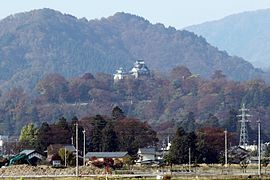Ōno Castle (Echizen)
| Ōno Castle | ||
|---|---|---|
|
Ōno Castle, castle tower |
||
| Creation time : | 1575 | |
| Castle type : | Hirayamajiro (hill castle) | |
| Conservation status: | Partly reconstructed | |
| Place: | Ōno | |
| Geographical location | 35 ° 59 '11.7 " N , 136 ° 28' 59" E | |
|
|
||
The Castle Burgno ( Japanese 大野 城 , Ōno-jō , also called Echizen -Ōno ( 越 前 大野 ) or Kameyama-jō ( 亀 山城 )) is located in the city of Ōno in Fukui Prefecture . In the Edo period , the Doi last resided there as a smaller Fudai daimyo .
Lords of the castle in the Edo period
- From 1624 a branch of the Matsudaira with 50,000 Koku,
- from 1635 a branch of the Matsudaira with 50,000 koku,
- from 1635 a branch of the Matsudaira with 50,000 koku,
- from 1682 a branch of the Doi with 40,000 koku.
history
In 1575 Kanamori Nagachika ( 金森 長 近 ; 1524–1608) built a hill castle in the western part of the Ōno plain on the Kameyama ( 亀 山 ). Nagachika was a vassal of the elder Oda Nobunagas , namely Shibata Katsuie . He belonged, together with Maeda Toshie ( 前 田 利 家 , 1538–1599) and Sassa Narimasa ( 佐 々 成 政 ; 1839–1588) to the "Three Greats of Fuchū" ( 府中 三人 衆 , Fuchū sannin shū ) and had the area of Nobunaga to get Ōno in the province of Echizen. At first he had used the old castle Inuyama ( 戌 山城 ) of the Asakura , but it was not conveniently located. So he soon moved to the intersection of the Hokuriku ( 北 陸 街道 , Hokuriku-kaidō ) and Mino highways ( 美濃 街道 , Mino-kaidō ) and built a modern castle there.
After the Battle of Shizugatake in 1583, Nagachika had to hand over the castle to Toyotomi Hideyoshi and was transferred to Takayama in Hida Province in 1586 . This was followed by the vassal of Yūki Hideyasu ( 結 城 秀 康 ), Doi Masaaki ( 土井 正 明 ), who took his own life on the occasion of Hideyoshi's death. His son Tadatsugu was then transferred. The Matsudaira came from 1624, until the Doi took over the castle again in 1682 and then remained lords of the castle until the Meiji restoration in 1878.
The attachment
At the top of the hill, the innermost castle area, the Hommaru ( 本 丸 ; 1), was created with a two-story castle tower ( 天 守 閣 , tenshukaku ), a small castle tower ( 小 天 守 , shōtenshu ), as well as the Tengu-shoin ( 天狗 書院 ) and the Asagi Watchtower ( 麻木 櫓 , Asagi-yagura ; T) at the eastern end of the hill. In 1775 a fire destroyed the Hommaru and its buildings. In 1795 the castle was restored, although the castle tower was not rebuilt.
At the foot of the mountain, in the second area, the Ni-no-maru ( 二 の 丸 ; 2), the residence protected by moats was created. Water for this was derived from the Akane River ( 赤 根 川 ; A). Upstream was the third area, the San-no-maru ( 三 の 丸 ; 3). This was an outside area, the Sotomaru ( 外 丸 ; S) in front of it, in which the main gate H ( 大 手 門 , Ōte-mon ) of the castle was. This lower area was connected to the castle on top of the Kameyama via the "Hundred Fathoms Slope Path" ( 百 間 坂 , Hyakken-zaka ; W).
In 1871 the castle was demolished. In 1968 the castle tower ensemble on the Kameyama was restored in concrete.
photos
literature
- Ikeda, Koichi: Ōno-jo in: Miura, Masayuki (ed.): Shiro to jinya. Tokoku-hen. Gakken, 2006. ISBN 978-4-05-604378-5 , p. 100.
- Aoki, Junrō: Echizen Ōno-jo in: Nihon no meijō . Hekisuisha, 1995.
- Nishigaya, Yasuhiro (Ed.): Echizen Ōno-jo. In: Nihon meijo zukan, Rikogaku-sha, 1993. ISBN 4-8445-3017-8 .







